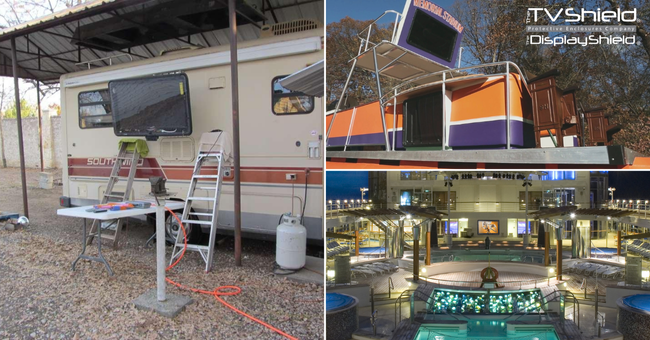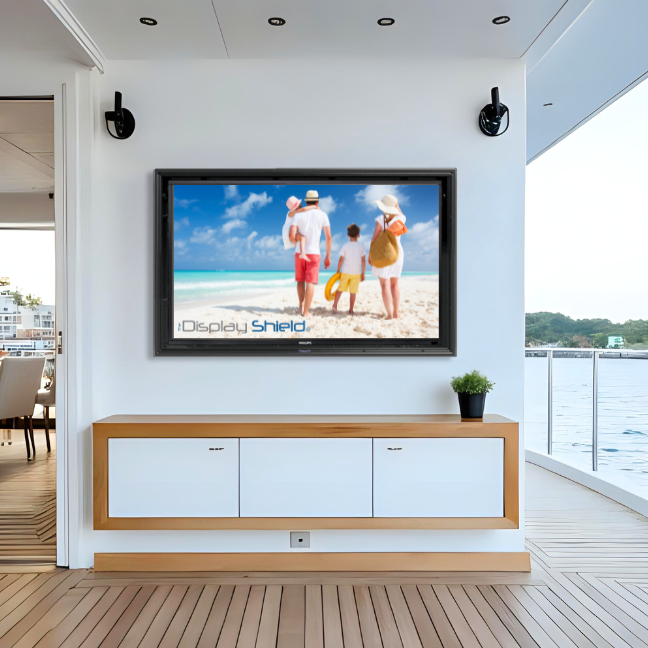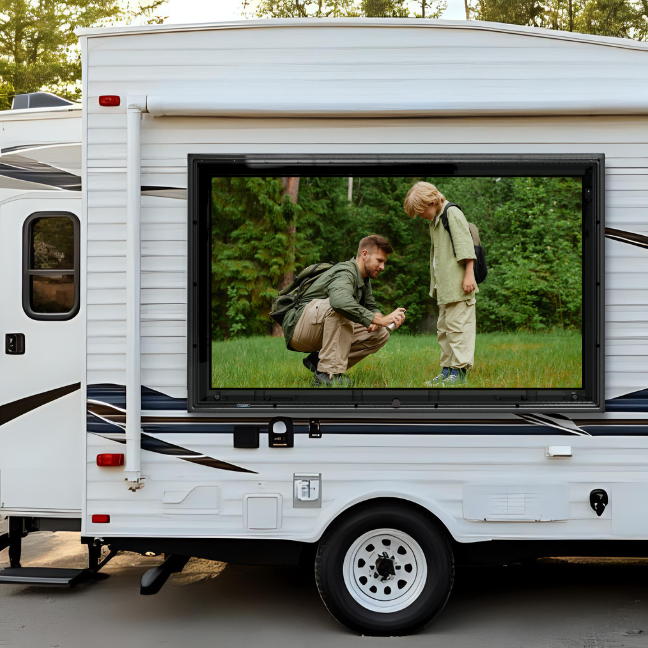Marine & RV Entertainment | The Display Shield
Posted by Emilyann Allen on 24th Nov 2025
Marine & RV Entertainment: Choosing a Salt-Spray-Safe Outdoor TV Enclosure
If you’ve ever tried to keep electronics alive on a boat, yacht, or RV, you’ll know that nature doesn’t make it easy. Salt spray, humidity, vibration, and relentless UV rays can make short work of even the most premium televisions. That’s why investing in a marine compatible weatherproof outdoor TV enclosure isn’t just a luxury, it’s an essential safeguard for anyone who loves entertainment on the move.

In 2025, the demand for mobile and marine entertainment is booming. Travellers want their movies, sports, and streaming services to follow them everywhere, whether it’s a floating cocktail hour on deck or a movie night under the RV awning. But these environments are uniquely hostile to electronics, which is where The Display Shield enclosures shine. With corrosion-resistant materials, sealed designs, and vibration-damping features, these outdoor TV cabinets deliver the reliability that high-end living on the move requires.
This guide unpacks what to look for in a marine compatible, waterproof, outdoor TV enclosure, and why The Display Shield has become the trusted choice for boat owners, yacht captains, and RV adventurers alike. Please note that marine compatible and waterproof does not mean water submergable - it means these enclosures are designed to withstand rain in forceful storms, water splashes, and salt-water air environments.
Table of Contents
- Why Marine & RV Environments Demand Special Protection
- IP Ratings Explained
- Anti-Corrosion Materials
- Vibration Damping
- Choosing the Right Marine Outdoor TV Enclosure
- FAQs
Why Marine & RV Environments Demand Special Protection
A living room TV lives a pretty easy life, consisting of a stable temperature, no salt in the air, no road bumps. On a boat or RV, it’s a different story.
- Salt Spray: Ocean air is loaded with sodium chloride particles that cling to metal and cause rapid corrosion. Even stainless steel can suffer over time.
- Humidity: Marine environments often exceed 70–80% humidity, encouraging condensation inside electronics.
- Motion & Shock: From pounding waves to pothole-filled highways, vibrations stress circuit boards, screens, and mounts.
- Temperature Swings: RVs parked in the desert or boats left in direct sun can see interior temps soar to 120°F or higher, while cool nights drop dramatically. And northern travel may involve snow.
Without protection any TV, even a premium outdoor-rated TV, may fail quickly in these conditions. That’s why a purpose-built enclosure is essential. Quality outdoor TV cabinets like The Display Shield turn almost any TV into a marine-ready or roadworthy unit.
IP Ratings Explained
When shopping for a marine outdoor TV enclosure, you’ll see references to “IP ratings” (Ingress Protection). This international standard rates how well a product resists dust and water, but these tests are rigorous beyond the protection which is typically necessary for RV, boat, and coastal environmental testings. High IP ratings are nice but drive up enclosure costs and are not needed in many environments. Rather than focusing on IP ratings, products like The Display Shield are built in a robust but affordable way with shatterproof and durable materials, filters and grommets on entry points like vents and cord entries, and top closure sealing systems. These features offer excellent dust-resistance and waterproofing for TVs in or on vehicles, boats, or on beach front properties. The Display Shield also offer thermostatic fans paired with vents which provide moisture control. Please note these enclosures are not designed to be actually submerged in water or liquids, but they are highly water and stormproof.
Anti-Corrosion Materials
Saltwater environments are unforgiving. Even if your enclosure keeps liquid out, airborne particles and sunlight can take their toll. The Display Shield is a great outdoor TV or digital display enclosure for saltwater air environments. The HMWPE High Molecular-Weight Polyethylene is corrosion-resistant, and even the hardware is designed to hold up well against saltwater air environments, such as at beaches or on boats. Protective Enclosures Company recommends you call to order The Display Shield so you can explain your specific installation environment to help you choose the best options for your enclosure for longevity in saltwater air locations.
The Display Shield Marine Stable Materials:
Corrosion-Resistant Housing and Hardware: This weatherproof TV enclosure's hardware and HMWPE High Molecular-Weight Polyethylene housing offer corrosion-resistance.
UV-Resistant Polycarbonate Front Panels: Prevents yellowing, brittleness, or cracking even after years of sun exposure.
Sealed Gaskets: Stops salt-laden air and fine spray from creeping inside.
The result? A setup that survives in environments where an ordinary TV or mount would corrode within a season. It's no surprise these enclosures are a popular pick for boats, yachts, beachside restaurants, and more.

Vibration Damping
A TV enclosure isn’t just about resisting water and salt. It also has to hold up under constant jostling.
- On Boats: When waves hit, the hull transfers sharp, repeated vibrations through every surface. Unprotected TVs can end up with cracked screens or solder joints, or loosened components.
- On RVs: Long-haul travel means continuous micro-vibrations, plus the occasional pothole shock.
Premium marine outdoor TV enclosures integrate or can accommodate:
- Shock-Absorbing Mounts: Distribute stress across the frame rather than into the TV itself.
- Internal Padding or Bracing: Keeps the screen snug and rattle-free.
- Reinforced Structure: Prevents twisting or warping of the enclosure during motion.
With these safeguards, your entertainment gear won’t shake itself to death on the open road or sea.
Choosing the Right Marine Outdoor TV Enclosure
Not all TV enclosures are created equal. Here are key things to weigh before you buy:
Size Compatibility: Check both diagonal screen size and depth. The Display Shield offers universal fit for many brands.
Material Quality: HMWPE or powder-coated steel will last much longer than wood or cheap plastic knockoffs.
IP Rating: IP rating can be helpful if the enclosure is directly at close range being sprayed ongoing every day from every angle, but for typical boat and coast environments with normal day to day ocean, lake, or beach side environments, looking for the following specific features is ideal... UV stable and shatterproof front panels, corrosion-resistant housing and hardware, filters, grommets, and sealing systems.
Anti-Theft Features: Locking mechanisms protect your investment in public marinas or campgrounds.
Mount Options: Use marine-grade or vibration-rated television mounts for safety and stability (we offer several anchoring solutions).
Portability vs Permanence: Decide whether you’ll leave it mounted year-round or remove it seasonally. The Display Shield outdoor TV cabinet is designed to be left year-round in extreme weather conditions.
By focusing on these elements, you’ll get an enclosure that doesn’t just survive but thrives in harsh conditions.

FAQs
- What makes a marine outdoor TV enclosure different from a regular outdoor enclosure?
Marine enclosures are specifically designed to withstand salt spray, salt-water air, high humidity, and constant vibration. They use anti-corrosion materials and reinforced mounts that go beyond the needs of a backyard patio TV. - Can I use a regular outdoor TV on a boat without an enclosure?
It’s risky. Even the best outdoor-rated TVs aren’t built for salt spray or constant vibration. Without an enclosure, lifespan drops dramatically, sometimes within a single season. - Do enclosures affect picture quality?
Not if designed correctly. The Display Shield’s polycarbonate fronts are crystal-clear, UV-stable, and there is an anti-glare option, so brightness and sharpness remain intact. - How do I choose the right IP rating for my setup?
IP rating can be helpful if the enclosure is directly at close range being sprayed ongoing every day from every angle, but for typical rainy, boat, and coast environments with normal day to day ocean, lake, or beachside environments, looking for the following specific features is ideal... UV stable and shatterproof front panels, corrosion-resistant housing, materials, and hardware, filters, grommets, and sealing systems. - What about extreme temperatures?
Truly weatherproof enclosures for direct outdoor exposure include ventilation systems and optional thermostatic fans or heaters to prevent overheating in direct sun, moisture, or condensation in cooler temperatures. - Are enclosures difficult to install on an RV or boat?
Not at all. With proper mounts, most installs take under an hour. Many RV and marine owners DIY with standard or manufacturer-provided tools. - Can I still access ports and controls on the TV once it’s inside?
Yes — enclosures like The Display Shield are designed with access panels and grommet protected cable pass-throughs for HDMI, USB, or power cords. - Do I need a special mount for boats or RVs?
Yes. Choose vibration-rated mounts that distribute loads evenly. Protective Enclosures Company, makers of The Display Shield, offers heavy-duty mounting solutions. - Will saltwater eventually damage the enclosure itself?
There should not be damage for a very long time if it’s a high-quality TV enclosure composed of corrosion-resistant materials. Corrosion-resistant HMWPE enclosures with anti-corrosion hardware and UV-stable materials resist long-term damage. Routine rinsing with fresh water after marine air or salt-water splashes exposure extends the life of TV enclosures even further. - How long can I expect my TV to last inside an enclosure?
Users of high-quality TV enclosures report TVs lasting years longer than expected (often outliving their normal service life) because the enclosure shields them from salt, heat, and vibration stress. Lower-quality TV enclosures such as thin or non-coated ABS plastic units without shatterproofing, proper vents, filters, sealing, and UV stabilization are not likely to last as long.
